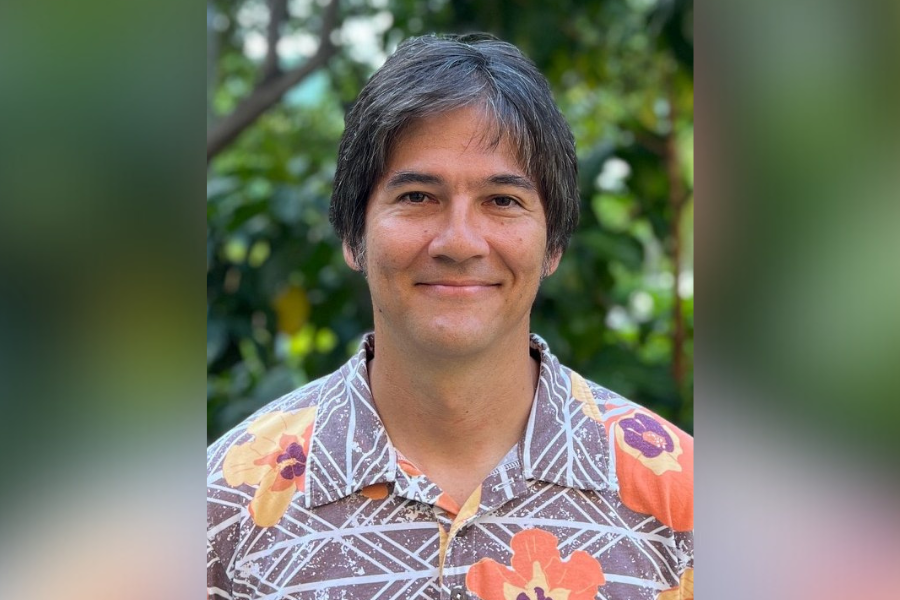
The research community has searched for a vaccine to prevent HIV since 1983, when it was first linked to the cause of AIDS. But an effective vaccine has eluded scientists for decades because HIV mutates so rapidly that it’s nearly impossible to generate an immune response that can shut down an infection.
University of Hawaiʻi John A. Burns School of Medicine researcher Iain MacPherson is working to advance a potential HIV vaccine through a new design that could better target the virus. MacPherson, an Assistant Professor in JABSOM’s Department of Tropical Medicine, Medical Microbiology & Pharmacology, was recently awarded a $410,813 grant from the National Institutes of Health (NIH) to support this project. The award is administered by the National Institute of Allergy and Infectious Diseases.
“Developing an HIV vaccine is one of the most difficult, complex problems in medicine,” MacPherson said. “We’re aiming to engineer an immunogen better capable of protecting people against diverse strains of HIV so we can help stem the spread of HIV.”
HIV, which is one of the deadliest infectious diseases across the globe, infects the body through a spike protein, much like how coronavirus spreads through the SARS-CoV-2 spike protein, MacPherson explains. But while coronavirus vaccines use that spike protein to help the body create antibodies that fight an infection, researchers haven’t been able to use that same approach for an HIV vaccine because the virus mutates so rapidly that vaccines can’t keep pace with the disease.
“HIV mutates at such an accelerated rate, that if you try to immunize a person with the spike protein from one strain of the disease, the likelihood of the immune response being able to neutralize a different HIV strain is essentially zero,” MacPherson explained, adding that HIV can mutate thousands of times in a single person and there are countless strains of the virus circulating around the globe.
“It’s really difficult to generate antibodies that can prevent an infection when the virus is so diverse,” he said.
But scientists believe that there could be an opportunity to leverage specific types of antibodies, known as broadly neutralizing antibodies (bnAbs), as blueprints to design vaccines that offer protection against a wide range of HIV strains.
While HIV mutates frequently, there’s a conserved region on the spike protein that remains largely unchanged through the evolution of the virus because it plays an essential role in the infection process. This conserved region infects immune cells called T-cells by binding to receptor, known as the CD4 receptor, and because it doesn’t change, it holds more potential for targeting through a vaccine.
“If an antibody can bind to that part of the HIV spike protein, it would block the interaction, neutralize the virus, and prevent it from being able to infect someone,” said MacPherson.
For over a decade, researchers have focused their attention on VRC01, a bnAb that can bind to the CD4 binding site (CD4bs) of HIV spike protein. The vast majority of the human population has specific types of B cells that can produce VRC01-like antibodies, but only after they undergo an evolutionary process called affinity maturation. VRC01 affinity maturation is particularly complicated compared to other antibodies and a considerable amount of research has been dedicated to trying to elicit VRC01-like antibodies through vaccination. MacPherson’s goal is to develop a vaccine model that can accelerate the production of these critical antibodies or other antibodies that have the same effect. Due to the complex nature of stimulating this response, a person would likely need to take a series of vaccines to shepherd along the process. MacPherson’s vaccine design would play an important role in the regimen of vaccinations that could help a person produce VRC01. Other researchers have attempted to develop a similar model, but none of them have produced strong results, even in animal models let alone humans.
“Our vaccine aims to focus the immune response on the specific B-cells that can eventually produce VRC01 and nudge them along in this evolutionary process,” he said. “We think that our design can more effectively target these important B-cells than prior iterations.”
MacPherson is collaborating on this project with Axel Lehrer, a Professor in the Department of Tropical Medicine, Medical Microbiology & Pharmacology, who specializes in vaccinology. The pair of researchers are leveraging molecular engineering and artificial intelligence-based protein design tools to develop this vaccine design. The pair will test their design on humanized mouse models to examine how effectively the immunogen can activate the target B-cells and how well the antibodies can neutralize against HIV.
If found to be effective, the targeting mechanism that MacPherson is developing could potentially be applied to any vaccine for generating specific antibodies to target conserved regions, including COVID-19 and influenza. In doing so, it could reduce or negate the need for annual boosters.
“The thing that really gets us excited is that we can potentially apply this high-level design to improve other vaccines, not just HIV vaccines,” MacPherson said. “The benefit of tackling the most difficult virus to vaccinate against, is that all of our research is helping us build tools and knowledge that we can apply to other vaccines and pathogens.”
MacPherson first worked on HIV vaccine development while he was at Brandeis University doing post-doctoral research in molecular engineering. He worked on a project that targeted another HIV broadly neutralizing antibody and has been thinking about HIV vaccines and following research developments since then. When MacPherson, who was born and raised in Hawaiʻi, returned in 2017 as an adjunct faculty member, he joined the University’s Hawaiʻi Center for AIDS research group, which focuses on HIV education, research and service and fosters collaborations to help find a cure for HIV.
“There’s been a lot of amazing work done in HIV vaccine development and we’re hoping that we can contribute part of the solution to the HIV vaccine problem,” he said.